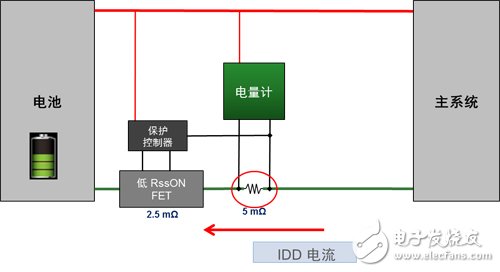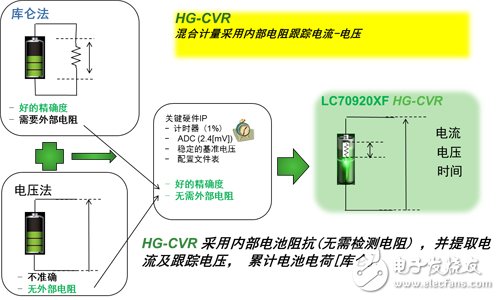Portable electronic products are becoming increasingly close to our lives, and the use of wearable devices has become a new trend in consumption. While the market is growing significantly, how to improve the accuracy of the fuel gauge has become an urgent problem to be solved. A conventional fuel gauge built into a wearable device can provide an accuracy of about ±8%. So if the indicator shows that the remaining charge is 10%, the actual value may be as low as 2%. Users often think that the device can work for a while, but the system suddenly shuts down unexpectedly, losing unsaved key data and work, which is inconvenient for the user's use. Imagine if this kind of malfunction occurred in the medical environment, it may be life-threatening.
By adding a fuel gauge component to improve the accuracy of the fuel gauge, it is possible to increase the size and weight of the device, and today's consumers need a slimmer, portable/wearable device that integrates more features, so Designers need to consider the use of energy-efficient components.
Traditional electricity metering scheme: Coulomb counting method
The coulomb counting method is the most commonly used electricity metering method, which uses a high-precision current detecting resistor to continuously monitor the output current of the battery. The current is integrated over time and the result is compared to the known maximum amount of electricity to calculate the remaining amount of power available.

Figure 1: Coulomb counting
The biggest drawback of the coulomb counting method is that it is very inaccurate, and the possibility of an unexpected shutdown is very high. Since the self-discharge current of the battery does not flow through the external sense resistor, it cannot be detected. Moreover, this self-discharge current is affected by the temperature of the battery, and the self-discharge event causes an increase in the ambient temperature to further affect the accuracy. In addition, accurate measurements can only be taken each time the battery is fully charged, and in fact the battery is not fully charged each time.
The coulomb counting method is not only inaccurate, but because it requires the detection of resistance, the cost increases and takes up more PCB space, and the detection current flowing through the detection resistor consumes additional battery power, interferes with the performance of the main battery, and increases power loss.
Hybrid measurement method based on internal resistance tracking current - voltage (HG-CVR)
ON Semiconductor's LC70920XF smart lithium battery fuel gauge IC provides an excellent solution to overcome the shortcomings of coulomb counting fuel gauges and solve these design challenges: an on-board fuel gauge based on precision analog-to-digital conversion (ADC) technology, and Built-in error correction and temperature compensation in the fuel gauge. Combined with low power operation and high precision metering, it ensures longer battery life by reducing wear and tear. In addition, the absence of external sense resistors means no power loss and saves valuable PCB space.
Based on a unique metrology method called HG-CVR, the LC70920XF measures the relative charge state (RSOC) of a battery with an error of ±2.8%, even under relatively unstable conditions, including temperature, aging, loading, and self-discharge.
A sophisticated reference voltage is critical to accurate voltage measurements. The LC70920XF has an accurate internal reference voltage circuit, which is unaffected by temperature, and stores a reference table in its memory, which includes data on the voltage/capacity, resistance/capacity, and resistance/temperature functions of the battery.
The HG-CVR method measures battery voltage, temperature, internal resistance, and open circuit voltage (OCV). OCV is the battery voltage of no load current. The measured battery voltage is divided into OCV and voltage as a function of load current. The varying voltage is generated by the load current and internal resistance. Then the current value is determined by the following formula:
V(VARIED) = V(MEASURED)-OCV
I=V(VARIED)/R(INTERNAL)
Where V(VARIED) is the voltage that varies with the load current, V(MEAUSRED) is the measured voltage, and R(INTERNAL) is the internal resistance of the battery. The internal resistance is affected by factors such as remaining power, load current, and temperature. The HG-CVR method extracts the charge (Coulomb) after monitoring the voltage and calculates it using the resistance profile and the voltage profile.
The remaining battery power is then calculated by continuously comparing the measured voltage and temperature to the values ​​in the reference table. When the battery voltage is lower, the readings are more frequent to ensure an accurate prediction when the remaining battery life becomes shorter.
Unlike other charge measurement methods, the HG-CVR method allows for battery self-discharge events without the need to fully charge the device's battery for calibration. Even if the battery is only charged to 50%, the remaining battery life can be accurately calculated.

Figure 2: ON Semiconductor's patented HG-CVR method
How to identify aging?
By repeating the discharge/charge, the internal resistance of the battery will gradually increase and the full charge capacity (FCC) will decrease. In the coulomb counting method, the RSOC is usually calculated using the FCC and the remaining capacity (RM).
RSOC = RM/FCC &TImes; 100%
The coulomb counting method must measure the reduced FCC in advance through the learning cycle. The HG-CVR measures the RSOC of the battery without the need for a learning cycle. The internal battery resistance used to calculate the current is highly correlated with the FCC. This correlation depends on the chemical function of the battery. The RSOC reported using this correlation is not affected by aging.
Automatic error convergence
One problem with coulomb counting is that the error accumulates over time, and the fuel gauge using the coulomb counting method must look for an opportunity to correct it. The LC70920XF with HG-CVR has the function of RSOC error convergence, and the error converges continuously from the estimation of the open circuit voltage. Moreover, the Coulomb counting method cannot detect accurate residual changes because the number of self-discharge currents is too small, but the HG-CVR method can accurately detect voltage information.
Easy to install quickly
In general, it is necessary for a fuel gauge to acquire multiple parameters, which typically consumes a lot of resources and additional development time. A unique feature of the LC70920XF is that multiple profiles are built into it, so the amount of parameters to be prepared at the beginning of the battery measurement is very small, simplifying the design and speeding up the installation.
Power-on reset / battery insertion detection
When the LC70920XF detects a battery insertion, it begins an automatic power-on reset. Once the battery voltage exceeds the reset release voltage (VRR), it will release the reset state and will complete initialization to enter sleep mode or operational mode. All registers are initialized after a power-on reset. If the battery voltage is much lower than the VRR during operation, the LC70920XF also automatically performs a system reset.
Low power consumption
The HG-CVR measures voltage and temperature for a preset period of time without the need for continuous monitoring circuitry, which allows the fuel gauge circuit to put itself into a power-saving sleep mode between measurement intervals without the need to sense resistors and reduce active power consumption.
The fuel gauge using the HG-CVR method reduces the number of components required and reduces power consumption. Taking the LC709203F as an example, it has four times less external component count than competing solutions, allowing design engineers to eliminate external current-sense resistors and reduce the printed circuit board size by approximately 77.5% in a compact package measuring 1.76mm x 1.6mm. It is about 45% smaller than the competitive solution, which not only reduces BOM cost and design time, but also improves reliability. Moreover, due to the reduced number of external components required, the LC709203F significantly reduces total power consumption, with an operating current of 15 uA, which is about 1/10 of the competing component 118 uA. In active mode, power consumption is reduced by 87%, and in sleep mode, power consumption is reduced by 60%.
All our items Suitable for space like meeting room, living room as well as restaurant, leisure club,office etc;
And all are packed in singel neautral box safely, mass production in carton case approved by drop test. We can make custom logo and box for bulk cargos. Please click to contact us freely if you have the query. We have different shipping options for you: Express, Air, Sea. Please choose your favorite way, or you can also refers to our recommendation.
We have our own Control systems: Shorten lead times at low cost with responsive production planning and with many years experience of producing products.
We could provide OEM / ODM service for all kinds of customers. Our professional support team will service online 24 hours for customers.
We have a very strong quality control Samples are always available for checking quality and Efficient Logistics.
Professional Design Team: artwork/ Instruction manual/ product design according to customer's requirements.
Smart Diffuser,Smart Aroma Diffuser,Smart Wifi Diffuser,Electric Aroma Diffuser
KIWA ELECTRONIC (HK) INDUSTRIES CO.,LTD , https://www.kiwahk.com